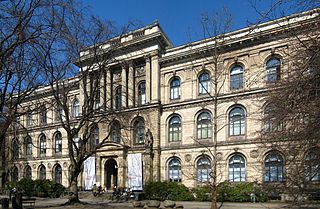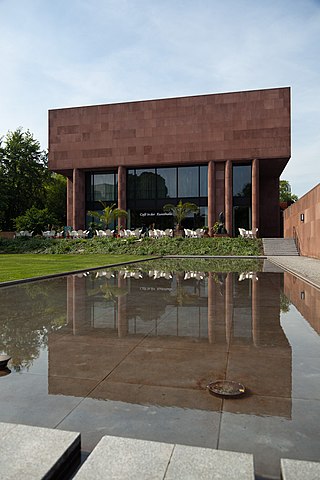
The Field Museum of Natural History (FMNH), also known as The Field Museum, is a natural history museum in Chicago, Illinois, and is one of the largest such museums in the world. The museum is popular for the size and quality of its educational and scientific programs, and its extensive scientific specimen and artifact collections. The permanent exhibitions, which attract up to 2 million visitors annually, include fossils, current cultures from around the world, and interactive programming demonstrating today's urgent conservation needs. The museum is named in honor of its first major benefactor, Marshall Field, the department-store magnate. The museum and its collections originated from the 1893 World's Columbian Exposition and the artifacts displayed at the fair.

The Royal British Columbia Museum, founded in 1886, is a history museum in Victoria, British Columbia, Canada. The "Royal" title was approved by Queen Elizabeth II and bestowed by HRH Prince Philip in 1987, to coincide with a royal tour of that year. The museum merged with the British Columbia Provincial Archives in 2003.

The Natural History Museum is a natural history museum located in Berlin, Germany. It exhibits a vast range of specimens from various segments of natural history and in such domain it is one of three major museums in Germany alongside Naturmuseum Senckenberg in Frankfurt and Museum Koenig in Bonn.

The Naturmuseum Senckenberg (SMF) is a museum of natural history, located in Frankfurt am Main. It is the second-largest of its kind in Germany. In 2010, almost 517,000 people visited the museum, which is owned by the Senckenberg Nature Research Society. Senckenberg's slogan is "World of biodiversity". As of 2019, the museum exhibits 18 reconstructed dinosaurs.

Naturkundemuseum, formerly Zinnowitzer Straße, is a Berlin U-Bahn station located on the U6 in the district Mitte.

The Museum Wiesbaden is a two-branch museum of art and natural history in the Hessian capital of Wiesbaden, Germany. It is one of the three Hessian State museums, in addition to the museums in Kassel and Darmstadt.

The Museum of Natural History in Görlitz, Germany is a natural history museum with focus on zoology, botany and geology. Since 2009, the museum has been part of the Senckenberg Gesellschaft für Naturforschung with headquarters in Frankfurt/Main. The main field of research is soil biology. In the years 2006 to 2017 the number of visitors was between 25,000 and 34,000, in the year of the 3rd Saxon State Exhibition 2011 it was even 47,000.

The Ottoneum in Kassel, Germany was the first theater building built in Germany and is now a museum of natural history.

The Kunsthalle Bielefeld is a modern and contemporary art museum in Bielefeld, Germany. It was designed by Philip Johnson in 1968, and paid for by the businessman and art patron Rudolf August Oetker.

A scientific collection is a collection of items that are preserved, catalogued, and managed for the purpose of scientific study.

The State Museum of Natural History Karlsruhe, abbreviated SMNK, is one of the two state of Baden-Württemberg's natural history museums. Together with the State Museum of Natural History Stuttgart it is one of the most important repositories for state-owned natural history collections.

Cyclotosaurus buechneri is a species of the temnospondyl genus Cyclotosaurus from the Upper Triassic of northwestern Germany.

Trix is a Tyrannosaurus rex specimen excavated in 2013 in Montana, United States by a team of paleontologists from the Naturalis Biodiversity Center in Leiden, the Netherlands and Black Hills institute of Geological Research in South Dakota. This Tyrannosaurus, over thirty years old – the oldest known Tyrannosaurus specimen – lived about 67 million years ago. It is considered to be the third most complete Tyrannosaurus found, with between 75% and 80% of its bone volume recovered. The specimen was named Trix after the former Queen Beatrix of the Netherlands. It is one of only two Tyrannosaurus specimens on permanent exhibit in mainland Europe. The other one is a specimen named Tristan on exhibit at the Natural History Museum of Berlin.

Arminisaurus is a genus of pliosaurid plesiosaur that lived during the Lower Jurassic in present-day Germany. With Westphaliasaurus and Cryonectes, Arminisaurus is only the third plesiosaurian taxon that was described from the Pliensbachian stage. The holotype and only known specimen is a fragmentary skeleton, comprising an incomplete lower jaw, teeth, vertebrae and elements from the pectoral girdle and the paddles. The animal had an estimated body length of 3–4 metres (9.8–13.1 ft).
Julius Riemer was a German factory owner, natural history and ethnological collector and museum founder.

The Kulturhistorische Museum Magdeburg(KHM) is a museum in Magdeburg for Cultural History. It was originally founded in 1906 as an art-historically oriented Kaiser-Friedrich Museum. The museum focuses on the history of the city in permanent and special exhibitions. Art-historical pieces are also presented. The Museum für Naturkunde Magdeburg is also located in the same building.

The Kölnische Stadtmuseum is the municipal history museum of Cologne, North Rhine-Westphalia, Germany. It is housed in the building of the historic Zeughaus with the adjacent Prussian Alte Wache Zeughaus.

The Museum of Municipal Collections in the Zeughaus is an interdisciplinary exhibition building in Wittenberg that presents objects from archaeology and urban history, as well as natural history and ethnology. The director of the museum is Andreas Wurda.






















